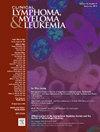Factors Predicting Spontaneous Regression in Other Iatrogenic Immunodeficiency-Associated Lymphoproliferative Diseases
IF 2.7
4区 医学
Q2 HEMATOLOGY
引用次数: 0
Abstract
Background
Other iatrogenic immunodeficiency-associated lymphoproliferative diseases (OIIA-LPDs) occur in patients taking immunosuppressive drugs (ISDs) for autoimmune diseases, such as rheumatoid arthritis and have been suggested to be associated with Epstein–Barr virus (EBV) infection. Although some patients regress spontaneously upon discontinuation of ISDs, factors predicting spontaneous regression (SR) remain controversial. Therefore, we conducted a retrospective observational study of the clinical characteristics and factors associated with treatment response, prognosis, and SR in patients diagnosed with OIIA-LPD.
Patients and Methods
We analyzed 82 patients at two institutions between 2002 and 2022, 41 (50%) of whom had SR after discontinuation of ISDs, with a 5-year overall survival (OS) rate of 86.3% and a median follow-up of 48 months (range, 9–201 months).
Results
The 5-year survival rates of the SR and non-SR groups were 96.9% and 77.2%, respectively. This value was significantly higher in the SR group (P = .001). The 5-year progression-free survival (PFS) rate for all patients was 60.1%, whereas the PFS rate for patients in the non-SR group who required chemotherapy was 54.4%. In univariate analysis, localized stage, good performance status, positive EBV-encoded RNA in situ hybridization (EBER-ISH) results, low C-reactive protein level, and low soluble interleukin-2 receptor (sIL-2R) level were associated with SR. Multivariate analysis revealed that EBER-ISH positivity and low sIL-2R levels were associated with SR (P = .016 and .012, respectively).
Conclusion
The OS was significantly longer in the SR group than in the non-SR group. EBER-ISH and sIL-2R levels are predictors of SR.
预测其他医源性免疫缺陷相关淋巴细胞增生性疾病自发消退的因素。
背景:其他医源性免疫缺陷相关淋巴增生性疾病(olia - lpd)发生在服用免疫抑制药物(ISDs)治疗自身免疫性疾病(如类风湿关节炎)的患者中,并被认为与eb病毒(EBV)感染有关。虽然一些患者在停用ISDs后会自发消退,但预测自发性消退(SR)的因素仍然存在争议。因此,我们对诊断为oia - lpd的患者的临床特征及与治疗反应、预后和SR相关的因素进行了回顾性观察研究。患者和方法:我们分析了2002年至2022年间两个机构的82例患者,其中41例(50%)在ISDs停药后发生SR, 5年总生存率(OS)为86.3%,中位随访时间为48个月(范围9-201个月)。结果:SR组和非SR组5年生存率分别为96.9%和77.2%。SR组的这一数值显著高于对照组(P = 0.001)。所有患者的5年无进展生存(PFS)率为60.1%,而需要化疗的非sr组患者的PFS率为54.4%。在单因素分析中,局部分期、良好的运动状态、ebv编码RNA原位杂交(EBER-ISH)阳性结果、低c反应蛋白水平和低可溶性白细胞介素-2受体(sIL-2R)水平与SR相关。多因素分析显示,EBER-ISH阳性和低sIL-2R水平与SR相关(P分别为0.016和0.012)。结论:SR组的OS明显长于非SR组。EBER-ISH和sIL-2R水平是SR的预测因子。
本文章由计算机程序翻译,如有差异,请以英文原文为准。
求助全文
约1分钟内获得全文
求助全文
来源期刊

Clinical Lymphoma, Myeloma & Leukemia
ONCOLOGY-HEMATOLOGY
CiteScore
2.70
自引率
3.70%
发文量
1606
审稿时长
26 days
期刊介绍:
Clinical Lymphoma, Myeloma & Leukemia is a peer-reviewed monthly journal that publishes original articles describing various aspects of clinical and translational research of lymphoma, myeloma and leukemia. Clinical Lymphoma, Myeloma & Leukemia is devoted to articles on detection, diagnosis, prevention, and treatment of lymphoma, myeloma, leukemia and related disorders including macroglobulinemia, amyloidosis, and plasma-cell dyscrasias. The main emphasis is on recent scientific developments in all areas related to lymphoma, myeloma and leukemia. Specific areas of interest include clinical research and mechanistic approaches; drug sensitivity and resistance; gene and antisense therapy; pathology, markers, and prognostic indicators; chemoprevention strategies; multimodality therapy; and integration of various approaches.
 求助内容:
求助内容: 应助结果提醒方式:
应助结果提醒方式:


